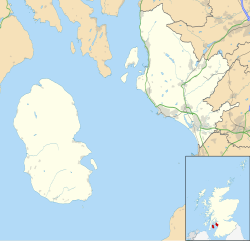Lochranza
| |
|---|---|
| Village | |
 Panoramic of Lochranza Bay, May 2008 | |
Location within North Ayrshire | |
| Population | 251 [2] |
| • Density | n/a |
| OS grid reference | NR929506 |
| • Edinburgh | 96 mi (154 km) |
| • London | 443 mi (713 km) |
| Civil parish | |
| Council area | |
| Lieutenancy area | |
| Country | Scotland |
| Sovereign state | United Kingdom |
| Post town | ISLE OF ARRAN |
| Postcode district | KA27 |
| Dialling code | 01770 |
| Police | Scotland |
| Fire | Scottish |
| Ambulance | Scottish |
| UK Parliament | |
| Scottish Parliament | |
| Website | North Ayrshire |
Lochranza (Scottish Gaelic : Loch Raonasa) is a village located on the Isle of Arran in the Firth of Clyde, Scotland. The population, somewhat in decline, is around 200 people.




